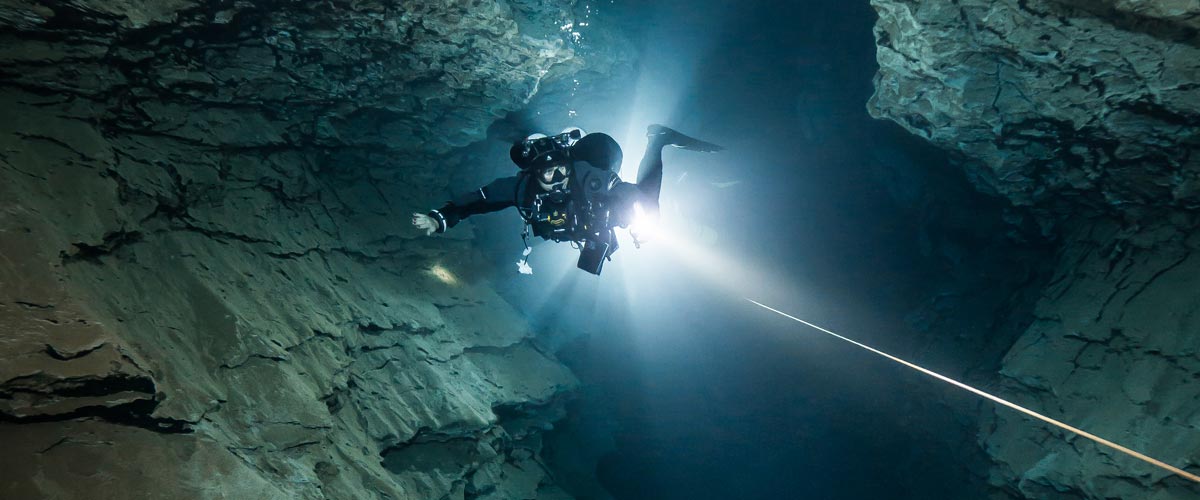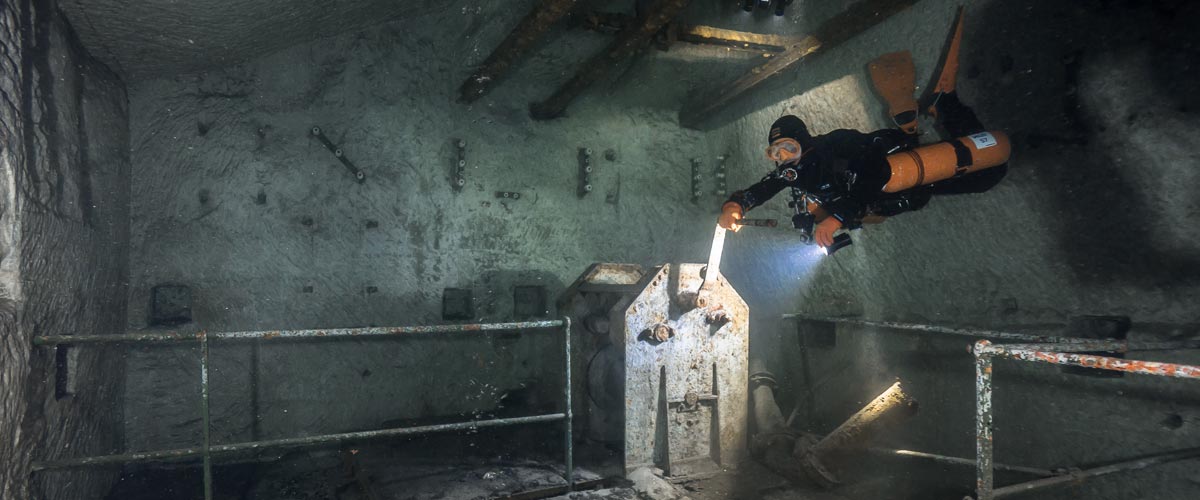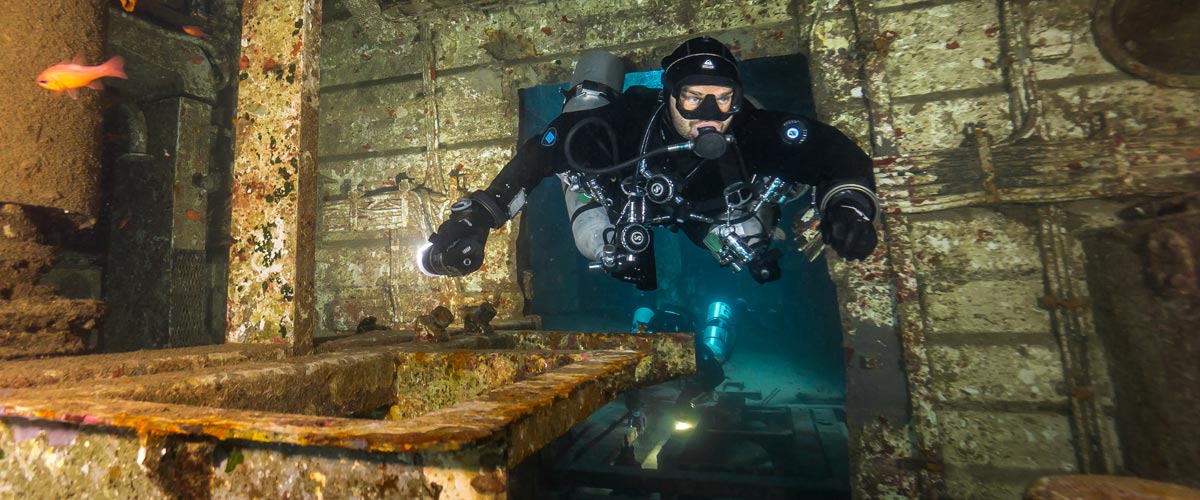Dive Training Blogs
Why we should all use Sidemount Diving Equipment
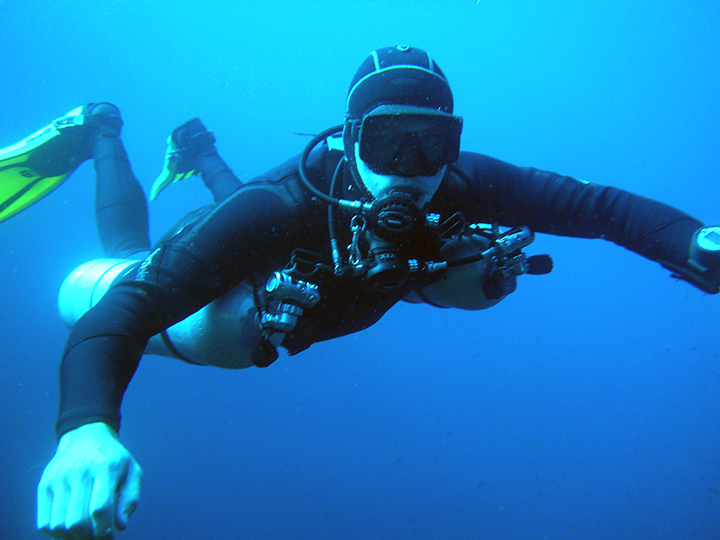
Many say “I don’t want to sidemount because I don’t want to carry two cylinders”!!
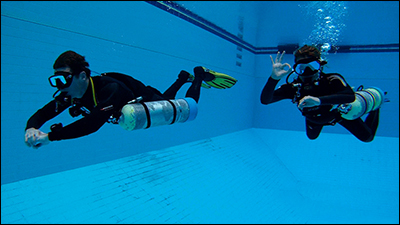 That is a very good point. For many divers, they see equipment overload and it does initially put them off, but why do you have to carry two cylinders I say… when you are in a warm water location (using a wetsuit) diving sidemount with one aluminium cylinder “at your side” is in fact a great way to dive, and a good way to start learning sidemount diving.
That is a very good point. For many divers, they see equipment overload and it does initially put them off, but why do you have to carry two cylinders I say… when you are in a warm water location (using a wetsuit) diving sidemount with one aluminium cylinder “at your side” is in fact a great way to dive, and a good way to start learning sidemount diving.
The divers I have trained in sidemount single cylinder really enjoy the freedom that having a cylinder off your back provides, and they quickly find that adding an additional 2nd cylinder after a few dives using a single cylinder is not much of a problem at all.
After a few dives more using two sidemounted cylinders correctly they then start to see the many added benefits of carrying x2 cylinders underwater. All this then results in a changed perspective from each of the divers and the problem of carrying two cylinders is no more (especially if you have someone else bring them to the water’s edge for you!).
So why do we have our cylinders on are back anyway?
My explanation for both guys and girls: picture yourself at home and the washing machine has just finished its wash cycle, you don’t have the spin dry function so your full load is still soaking wet… you look outside and it’s a sunny day, so you decide to use your washing line.
I bet you generally empty the wet washing into a basket, then pick up the basket using the two handles on either side and carry this approx 100 to 200 yards to your washing line. Not too much of a problem carrying that weight for such a short distance, right?
Now I want you to imagine that same heavy wash basket, the weather is not suitable for drying outside, and your partner has the car, so your only option is to walk to your local laundrette… which is 10 minutes from your house. Do you still fancy carrying that wash basket?
No, me neither! It is too heavy for just our arms to carry, so what we do is find either a rucksack or bag with wheels and put the washing in there for transport. This is because it is much easier to carry the heavy load on our backs.
This is the exact same problem we are all faced with when using our even heavier scuba diving equipment. Again, picture yourself – you have your normal cylinder, bcd, regulators and lead weights, you’re at the dive site and the walk to the water is a good few hundred yards away. It makes sense our BCD’s are designed like a backmounted rucksac, it makes carrying are SCUBA gear to the water possible.
Once you make it to the water, what a relief to get that weight of your back, right? 🙂
Underwater we can feel weightlessness by adding air to our BCD which allows us to become neutrally buoyant, but what we still can notice is when we move and especially change orientation by turning onto our side, upside down we feel the weight of our backmounted equipment shift. This is due to our centre of gravity changing due to placement of equipment on our back.
When using sidemount equipment our centre of gravity shift is not like backmount as the sidemount cylinders balance each other out all the time, and the positioning of the cylinder(s) gives you a much more streamlined profile. This creates real underwater freedom, comparable to that of a freediver!
I think backmount BCDs were originally designed like a rucksack, as an easy way to carry our equipment from land into the water while keeping our hands free… not because backmounted equipment actually performs better underwater.
Another huge advantage to sidemount diving, if you think back about that few hundred metres walk to the water I mentioned earlier, is the walk can be made much easier by setting up the regulators on the cylinders and then leaving them at the dive site entrance point prior to the dive. You then get changed into your exposure suit and sidemount BCD and walk relatively weight free to the water’s edge; once there, you can then put on your sidemounted cylinders (in the water) and go diving, without all the stress and strain of the walk with equipment normally on your back!
Thinking back to the story, you could say that diving in sidemount is just like doing your washing at the laundrette in the first place!! 😀
Is sidemount really that much better than backmount under the water?
Yes. Let me explain – backmounted equipment is not as hydrodynamic as sidemount equipment, meaning that when using sidemount you can achieve:
- More buoyancy control through better streamlining of your equipment.
- More comfort as your spine can flex as it is supposed to do.
- More propulsion and glide efficiency from every kick you make.
- More tasks like operating your BCD inflator and deflator become easier.
- More comfort knowing you have extra redundancy in case of equipment failures.
- More available air supply, for you and your buddy.
- Complete redundancy if a regulator fails for any reason.
All this results in you having more time and less stress underwater.
Top 5 benefits for why you should choose sidemount
- Generally most sidemount harnesses are custom fit, which adds comfort and allows correct fitting for all body shapes & sizes.
- Having the option to put on the heavy bits (cylinders) in water first, makes scuba diving far easier and gives you more energy for swimming underwater.
- Being more streamlined underwater makes more dive sites accessible, as many sites have challenging conditions like currents, long swims, etc…
- For many people sidemount makes technical diving possible (no twinsets to carry).
- Using sidemount diving just looks way cooler and much more fun!!!
So when you really think about it, Sidemount equipment is better than backmounted equipment in nearly every way you can imagine…
I thank you for taking the time to read this article and hope you have enjoyed its contents. You may have lots of questions after reading this – don’t worry, I am expecting them; after all, I designed the article this way 🙂
I have been diving for over a decade now; my only wish is that I had discovered Sidemount diving from the beginning. Most of you have the chance to do what I could not! Sidemount scuba diving really is the future!
Sidemount Experience with Steve Martin YouTube Video: http://youtu.be/0XQivbDCCZk
Find out more about Steve Martin through his Facebook Page: www.facebook.com/sidemounting
Blogs
Intro to Tech: What is it about?
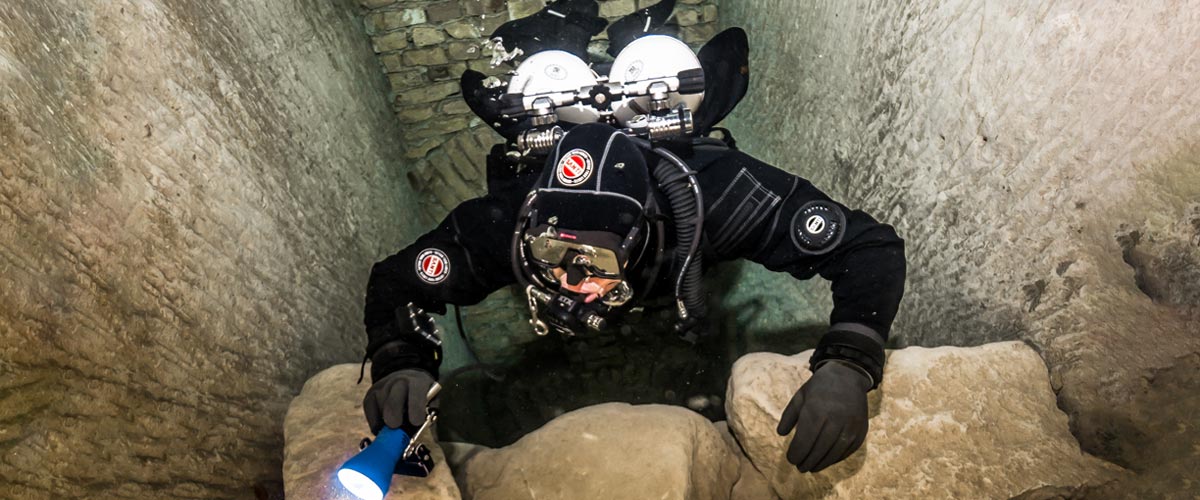
Article by José Pablo Mir
Pictures by Cezary Abramowski
The world of technical diving is exciting. It opens the door to new sites, depths, and bottom times. More importantly, it opens our minds to a new way of planning, facing, and experiencing dives, even those not purely technical.
Becoming a technical diver is a process, and like in other aspects of life, we should find the proper entry point that suits us best based on our knowledge and experience. The Introduction to Technical Diving course from TDI -the world’s largest and most recognized technical diving teaching organization- is the best option for divers who have yet to gain experience in the fundamental aspects of this new practice. The course’s content and its embrace of new techniques and technologies make it possible to acquire a solid foundation to learn and gain experience in this practice properly.
Becoming a technical diver is not something that happens overnight, whether deciding to become one or receiving a certification card stating we are now technical divers. It is a slow process extending farther away than any introductory course. It requires effort and dedication. But it will bring us satisfaction from day one -or two.
It is a matter of mentality
First, we must understand and accept that technical diving, involving greater depths, longer bottom times, exotic gases, virtual or real ceilings, and more, comes with higher levels of risk than the sport diving we have been practicing until now.
Although this discussion usually starts with a warning about risks, as I’ve done in the previous sentence, our practice is not a game of chance.
Technical diving is a rational activity that requires maturity and good judgment, and we will put everything into ensuring that each dive is a successful one -meaning we return from it safe and sound. With this understanding, we will strive to establish a mental attitude more aligned with our practice and its realities.
This new “technical diver” mindset we will develop will lead us to be more cautious in our executions, more analytical in our plans, more rational in our strategies, and more detailed in our procedures.
Experience will keep teaching us to know ourselves better, to keep our anxiety and other emotions under control, and to manage our impulses. Over time, our senses will sharpen, and we will be more attentive to the particulars of the situation we find ourselves in.
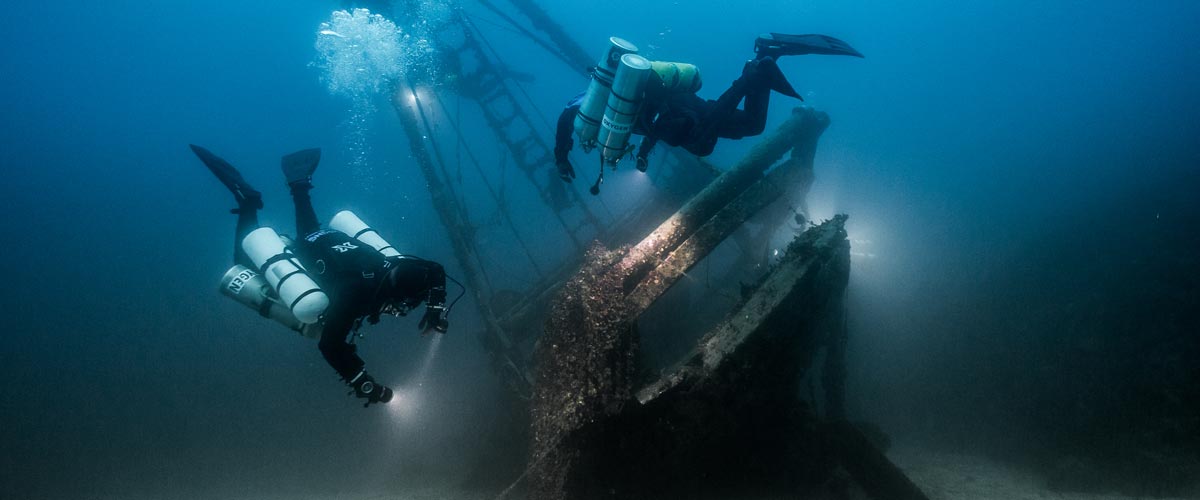
Strategies and procedures
Our strategies, those broad guiding lines tracing the path to follow, from how to approach planning to where, with what, and how we are willing to get there, will be more specific and more practical. Not because they magically become so, but because we will consciously and deliberately frame them that way.
We will establish clear, concise, and realistic procedures. Not only for the undesirable situations that may present themselves but also for those that are part of our dive objectives.
Even though, as technical divers, we often use equipment different from what we were previously accustomed to, it is essential to note that the gear does not make the diver. In a way, we could consider such equipment as the necessary tools to implement what our goal seeks to achieve, according to our strategies and procedures.
Technique plays an important role
We must put our greatest effort into learning and perfecting the different techniques we will be acquiring. Buoyancy, trim, propulsion, cylinder handling, deploying DSMBs and lift bags, valve drills, and more are essential skills we must begin to master to progress in our art. What we cannot do, when we need to do it, can harm us.
Our techniques must be effective and achieve the purpose for which they were devised. But they must also be efficient and require the least resources possible, including the time they take and the effort they demand. Effectiveness and efficiency will prevail over beauty and other considerations that may come to mind, although none of them should be mutually exclusive. A technique executed efficiently and effectively tends to have an inherent beauty.
Refining techniques is a lifelong mission. Some of them will be easy to master from the go; others, on the other hand, will be our life mission and will require many repetitions just to resemble the idea we have in mind of how they should be executed.
We must consider the environment
Our learning, the needs and musts of the practice we engage in, the experience we gradually gain, our strategies and procedures, and even our equipment and tools change with the environment.
Diving in the ocean, everything about us must be suitable for ocean dives. Conditions there rarely emulate those found in a pool, lake, or river. Variable winds and currents, greater depths, visibility conditions, other divers with uncertain skills around us, marine life, maritime traffic, distance from the coast, and many other factors add complexity and uncertainty.
It is never necessary to master the pool on the first day, but planning and aspiring to gradually cope with the ocean’s conditions is essential.
The cost of good training
We are aware that our resources are often scarce in relation to the possibilities of use we could give them if they were not. To a greater or lesser extent, we are part of the economic reality in which we are embedded.
Fortunately, the cost of good technical diver training is not an entry barrier. Comparing training and equipment costs, we see that the former are generally lower. Yes, lower cost for personalized service, essential to our future
performance and safety, than for a series of mass-produced products that are mere, albeit necessary, tools for an end.
The value of good training
The value of the training we received encompasses a range of characteristics, from emotional and methodological to technical and technological. TDI and its Introduction to Technical Diving course offer a deep and modern approach, with a teaching strategy that aims to create thinking divers, not merely obedient ones.
As technical divers, our knowledge is our primary tool. In this type of activity, what we don’t know can harm us.
Is this course optional?
Unfortunately, the fact that this Introduction to Technical Diving course is not a prerequisite for any subsequent training is an invitation to consider it optional. And we all know what usually happens to “optional” under budget constraints.
However, this course should be seen as optional only by those divers who are somehow familiar with the use of technical equipment, who have a mindset more in line with the requirements of this type of diving, who plan and execute the dives the proper “technical” way, who know their gas consumption rate, who are not intimidated by non-decompression tables, who feel comfortable using their dive computers, and know the techniques and have at least an acceptable level of buoyancy, positioning, and propulsion. Those can go straight to a more advanced training course, such as TDI’s Advanced Nitrox.
We must ask ourselves whether or not we are in that group.
Remember our goal: to have fun
Recreational diving is our passion. Jumping into the water carrying heavy equipment and having properly dotted our I’s and crossed our T’s have only one ultimate goal: fun. This is the activity we have chosen as a hobby. We must enjoy it; it must give us pleasure and make us vibrate.
Having a good time is not optional!
Blogs
Four opportunities to go pro in 2024 with Dive Friends Bonaire
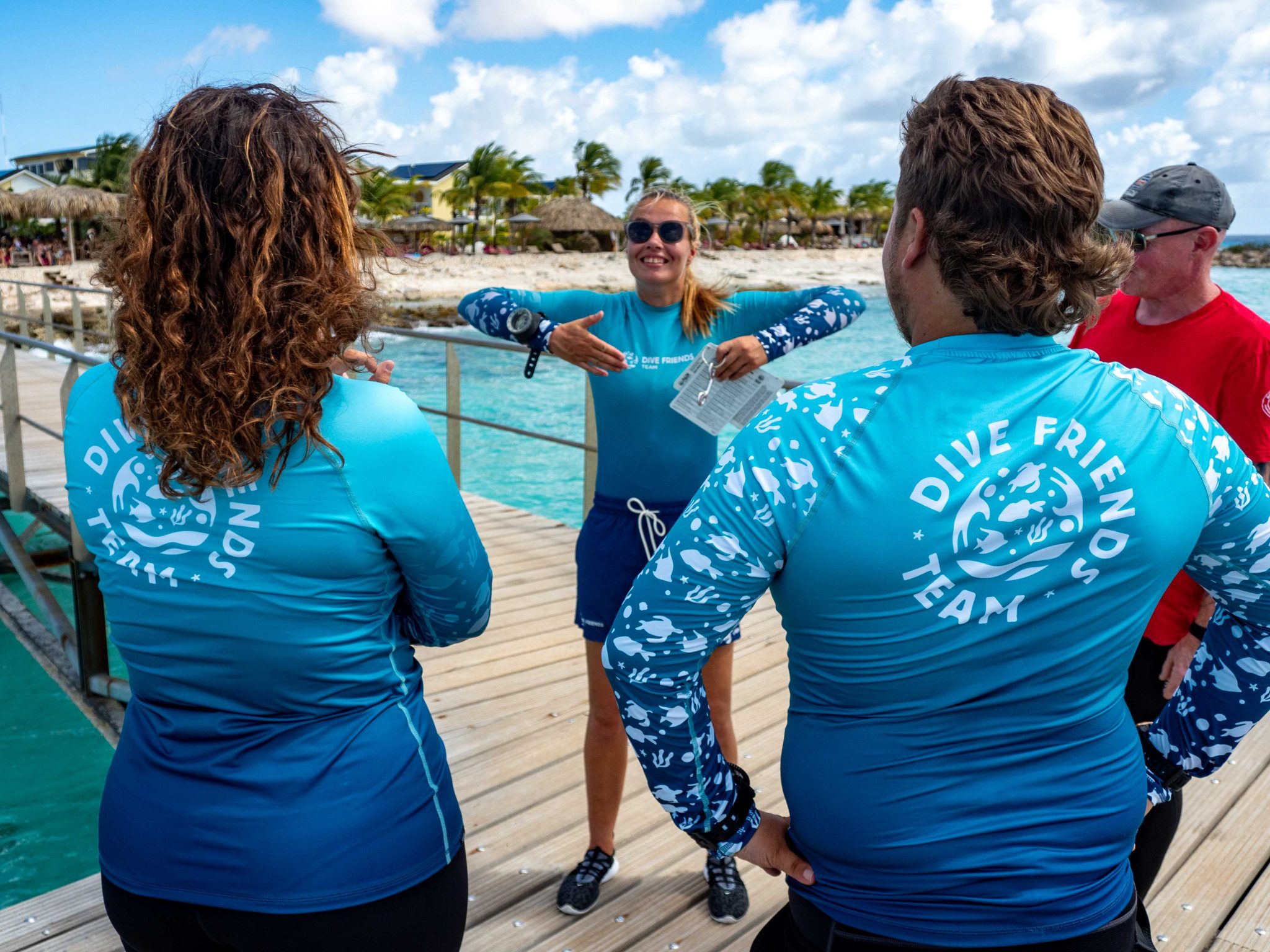
Dive Friends teaches the Instructor Development Course (IDC) several times a year to students who are eager to share their passion for diving with the world.
Dive Friends is known for the personal approach throughout the course. Their in-house course director will lead the students through every essential step, mentoring them to achieve their fullest potential as a dive instructor.
Applications for the following IDC start dates are now open:
- 12 April
- 5 July,
- 20 September
- 29 November
Partnership with Casita Palma
If the student opts for the IDC-Deluxe or IDC-Supreme package, their accommodation will be arranged for them at Casita Palma. This small and quiet resort is within walking distance from Dive Friends Bonaire’s main dive shop location and has everything you need to relax after an intense day of IDC training. Breakfast is included, so the student will always be fuelled and ready for their day.
Contact Dive Friends Bonaire’s Course Director Eddy for more information: coursedirector@divefriendsbonaire.com.
-

 News3 months ago
News3 months agoHone your underwater photography skills with Alphamarine Photography at Red Sea Diving Safari in March
-

 News2 months ago
News2 months agoCapturing Critters in Lembeh Underwater Photography Workshop 2024: Event Roundup
-

 Marine Life & Conservation Blogs2 months ago
Marine Life & Conservation Blogs2 months agoCreature Feature: Swell Sharks
-

 Blogs2 months ago
Blogs2 months agoMurex Resorts: Passport to Paradise!
-

 Blogs2 months ago
Blogs2 months agoDiver Discovering Whale Skeletons Beneath Ice Judged World’s Best Underwater Photograph
-

 Gear News3 months ago
Gear News3 months agoBare X-Mission Drysuit: Ideal for Both Technical and Recreational Divers
-

 Gear Reviews2 months ago
Gear Reviews2 months agoGear Review: Oceanic+ Dive Housing for iPhone
-

 Marine Life & Conservation2 months ago
Marine Life & Conservation2 months agoSave the Manatee Club launches brand new webcams at Silver Springs State Park, Florida















